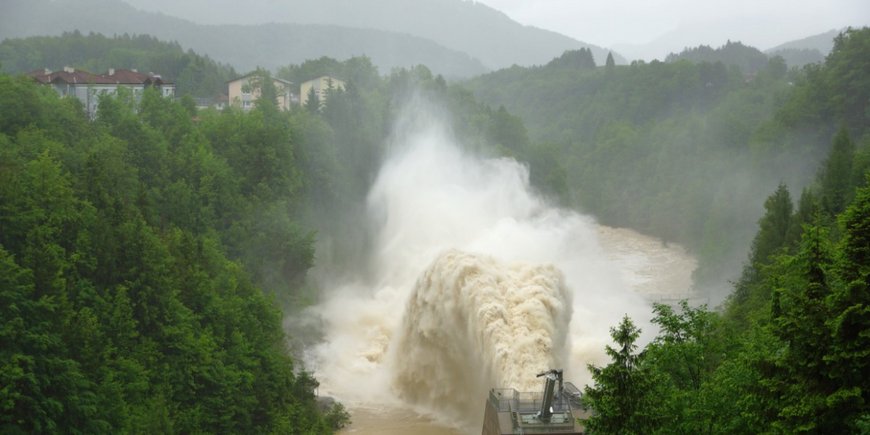Record soil moisture in May increased the June flood
05.06.2013 | Potsdam: The catastrophic floods in the south and east of Germany were substantially intensified in that the soils were saturated with moisture by the wet spring. The heavy rains could therefore not be absorbed into the soil. This is conclusion reached by the Center for Disaster Management and Risk Reduction Technology (CEDIM) after an analysis of the characteristics of the current floods and the comparison with previous events.
An extensive low pressure system consistently carried moist air to Central Europe from 27 May to 3 June. As a result, Germany, the Czech Republic, Austria and Switzerland experienced persistent and intense - albeit rarely record-breaking rainfall - due to the congestion effects particularly on the northern edges of the Central Uplands and the Alps. In particular, the combination of the extremely adverse preconditions - the ground could not absorb the new rainfall after a very wet May (40% of the land area of Germany featured new records of soil moisture at the end of May) - led to this extreme flood event.
From a hydrological point of view, the June 2013 flood already exceeds the flood of August 2002, and as a "modern" flood event is arguably only comparable with the event in July 1954, because the extent of the affected areas exceeds 40% of the German water bodies. Also, the peak outflows reached values in the magnitude these two historic events had, while it should be noted that the values of the Elbe and Saale rivers are currently rising.
In addition, it is very unusual for so many river basins to be affected simultaneously by very extreme floods. When such events are defined as floods with a recurrence probability of about 50 years, then, in contrast to 2002, clear focus points of the events cannot be determined. If the assessed damage does not reach the level of the August 2002 flood, it is due to the progress in flood protection, the absence of dike breaches and predominantly affected areas with a "flood experienced" population. These include the area around the river Elbe and regions of southern Germany that can deal comparatively well with flood impacts due to the type of terrain, urban settlement and socio-economic structure.
The full report can be found here:
http://www.cedim.de/download/FDA_Juni_Hochwasser_Bericht1.pdf
Contact: Dr. Florian Elmer, Tel. +49-331-288 1506
CEDIM is an interdisciplinary research institution in the field of disaster management and is jointly operated by the GFZ German Research Centre for Geosciences and the Karlsruhe Institute of Technology KIT. It contributes to the Earth System Knowledge Platform (ESKP) of the Helmholtz Association, which will provide current as well as background information on extreme weather and climate events online, starting in the second half of 2013.








![[Translate to English:] Torsten Sachs in front of a climate station on a field](/fileadmin/_processed_/3/9/csm__TorstenSachs_bearbeitet_GS_4a1365ef84.jpeg)

![[Translate to English:] left image flood at the Ahrtal: image from above, several houses are flooded; left image:: Heidi Kreibich;](/fileadmin/_processed_/4/4/csm_Bild2_9af0130e9f.png)



![[Translate to English:] Start der Vega Rakete](/fileadmin/_processed_/6/4/csm_20231201-kachel_Vega-VV23-launch_ESA-CNES-Arianespace_706716b68c.jpeg)









![[Translate to English:] Poster exhibition at the Brandenburg Hydrogen Day at the GFZ, some participants in the foreground](/fileadmin/_processed_/6/5/csm_Erster_Brandenburgischer_Wasserstofftag_GFZ_402fcec95e.jpeg)
![[Translate to English:] Group picture of the participants](/fileadmin/_processed_/9/4/csm_20231108_CAWa-Workshop-Tashkent_Gruppenbild_99ea779d8a.jpeg)

![[Translate to English:] [Translate to English:] Hörsaal](/fileadmin/_processed_/e/6/csm_H%C3%B6rsal_e21ac645fb.jpeg)


![[Translate to English:] The Delegations in the Historic Library on the Telegrafenberg. In the back there are from left to right, the Dutch Ambassador for Germany, Ronald van Roeden, the Dutch Minister for Education, Culture and Science, Robbert Dijkgraaf and the scientific director of the GFZ, Susanne Buiter.](/fileadmin/_processed_/d/b/csm_Kachel-2_9eba4b4212.jpeg)

